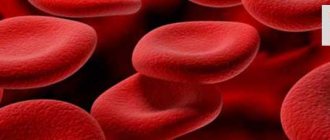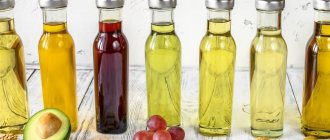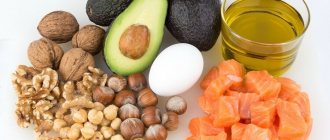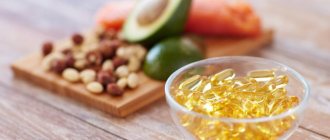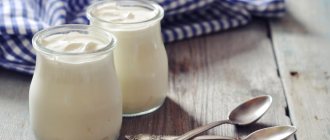We will tell you which fats should be completely excluded and which ones should definitely be included in the diet.
In fitness circles, when it comes to health, weight loss or muscle gain, people often misunderstand the role of fat in these processes. You can often hear the following questions: “What fats should I eat?”, “Do I need fat in my diet?”, “Will I gain weight if I eat fats?”
It's time to clear up some questions and learn what dietary fats are, which ones are healthy, which ones you should avoid, and finally, which fats are the best for weight loss.
What are fats?
The fats we eat are an integral part of the human diet. For normal functioning of the body, you need to consume a certain amount of fat daily. They perform many important functions in the body, including helping to produce powerful hormones such as testosterone. They also support cellular processes and are an important source of resting energy.3
Fats are very high in calories; one gram of fat contains about nine calories. This is slightly more than double the calories of protein and carbohydrates.3 While it is important to include some fat in your diet, you need to be careful not to overeat and end up with an unwanted calorie surplus that leads to weight gain. Many sources state that twenty to thirty percent of our daily calories should come from fat.5 Of course, these numbers can be higher if you eat a high-fat, low-carb diet, but it is not recommended for an extended period time to get less than twenty percent of calories from fats.
What fats are needed for weight loss
The right fats keep the body healthy. Without them, the process of hormonal metabolism and rapid satisfaction of hunger is impossible. The right fats promote weight loss and fat burning, renew the skin and improve the condition of the gastrointestinal tract.
They are divided into 4 main types:
- Saturated – synthesize sex hormones, increase the content of healthy cholesterol. Source: animal products.
- Monounsaturated – promote the breakdown of lipids (fats), remove unnecessary cholesterol, these are the fats you need when losing weight. Source: high-calorie foods of plant origin.
- Polyunsaturated compounds are the basis for cell formation and do not accumulate in the body. The main source is fish and plant products. To lose weight, daily intake of fats from this group is also required.
- Trans fats are the most dangerous, leading to obesity and diabetes. Contained in industrial sauces, seasonings, sweets, fast food.
The list of fats for weight loss includes mono and polyunsaturated fats. At the same time, the healthfulness of fats is influenced by the method of preparing foods.
Important! Fast food products have a high glycemic index, which leads to disruption of natural chemical reactions of cells, metabolic processes, and weight gain.
The structure of fats can be determined visually. Unsaturated fats are liquid, saturated fats are solid. Diets containing healthy fats help combat 21st century diseases Alzheimer's and Parkinson's.
What does “healthy fats” mean?
Many people have different understandings of what healthy fats are. There's actually no clear scientific definition of healthy fats. There are two main groups of fats—unsaturated and saturated (these groups are further divided into subcategories). Saturated and unsaturated fats differ in the number of carbon bonds in the molecule. Unsaturated fats contain double bonds between carbon atoms. Saturated fats have single bonds between carbon atoms, so they end up much closer together than in unsaturated fats.7
Healthy High Fat Foods
Most of the fats in your diet should be unsaturated. They, in turn, as mentioned above, are divided into two groups - monounsaturated and polyunsaturated fats.
Healthy sources of unsaturated fats:
- avocado;
- almonds, walnuts, pistachios and other nuts;
- nut butters (watch out for added sugars);
- olives;
- olive oil;
- flax seeds;
- salmon;
- soya beans;
- sunflower seeds;
- chia seeds.
Healthy sources of saturated fat:
Consume in limited quantities
- eggs;
- beef (from grass-fed cattle);
- whole milk;
- whole milk yogurt.
Healthy fats vs. bad fats
Generally, unsaturated fats are considered healthier. It is recommended that you meet about 90 percent of your daily fat needs from unsaturated fats. Saturated fats are associated with cholesterol, hence the recommendation to consume a maximum of 10 percent of these fats.8
Most recommendations are created to prevent cardiovascular disease and maintain heart health. Unsaturated fats contain high amounts of HDL (a lipoprotein that carries cholesterol away from the heart) and LDL (a lipoprotein that carries cholesterol into the heart).4
Unsaturated fats are often liquid at room temperature. They are classified into two different types: monounsaturated fats and polyunsaturated fats.
- Monounsaturated fats
They are usually found in plants. Sources include avocados, vegetable oils, nuts and seeds. These fats have been linked to improved heart health, reduced inflammation, weight loss, and increased insulin sensitivity.9
- Polyunsaturated fatty acids (PUFAs)
Plants and seafood products can be sources of PUFAs. Due to their high content of omega-3 fatty acids, polyunsaturated acids are often mentioned in the press. As a rule, fats from seafood are better absorbed by the body than the same fats of plant origin. The effects of these fats on the body have been linked to cardiovascular health, brain development in children, reduced inflammation, and immune system health, to name a few.9
- Saturated fats
They are often mistaken for unhealthy fats. Saturated fats are typically linked to heart disease because they are high in cholesterol. However, this idea has been refuted by scientific research - they are not considered harmful to the heart, especially in the absence of a calorie surplus (when you consume more calories than you burn).4
Saturated fats can solidify at room temperature and are more common in animal products. Due to their high cholesterol content, they play an important role in the production of steroid sex hormones and in brain function. Therefore, some of them must be included in the diet. If you are unsure how much to take, stick to the national health guidelines: no more than 10% saturated fat per day.4
- Trans fats
They may be called differently. If you come across the word hydrogenated or partially hydrogenated, then we are talking about trans fats. These are artificially created, unsaturated fats that undergo a processing process that causes them to become solid at room temperature. They should not be included in a healthy diet in any quantity. Studies have linked the presence of even small amounts of trans fat in the daily diet to a sharp increase in the risk of cardiovascular disease.1
The health benefits of trans fats are zero. Legislation in many countries requires that trans fats be listed separately on consumer packaging. They are often added to packaged baked goods or cookies because these fats extend the shelf life of foods.1
Summary:
Unsaturated fats have been proven to be healthy and are considered the healthiest fats. Saturated fats have some important health benefits, but their intake should be limited. Trans fats should not be present in the diet and should be avoided at all costs; even small amounts can cause significant harm to health.1
What products to choose for weight loss
As mentioned above, products of plant origin are beneficial. Monounsaturated fats break down lipids and do not accumulate as fat deposits. Polyunsaturated fats accelerate metabolic processes and promote rapid saturation, which also leads to weight loss. According to most nutritionists, some foods must be included in the list of foods with healthy fats for weight loss.
These include:
- Fish oil is valuable because it contains two beneficial acids: eicosapentaenoic acid (EPA) and docosahexaenoic acid (DHA), which are responsible for skin health and weight loss. Contained in the liver of cod, herring, salmon, tuna, it maintains insulin levels, which determines the level of obesity.
- Meat is a source of monounsaturated fats that break down lipids; it is found in dietary meat from calves, lambs, and kids.
- Vegetable oil is a supplier of polyunsaturated fats, improves digestion and metabolism, stimulating the loss of extra pounds. Cold olive and flaxseed oils are considered the best.
- Nuts are a source of healthy fatty acids. 10 g of different nuts contain different amounts of fat. The rating is topped by hazelnuts (4 g), almonds (3 g), pistachios (2 g), and walnuts (0.7 g). A serving of nuts should not exceed 20–30 g, which contains the daily amount of fat for weight loss.
- Avocado – 10 g contains 1 g of fat, an effective source of omega-9 monounsaturated fats.
- Olives are the second plant source of omega-9 after avocados.
- Dark chocolate – accelerates the breakdown of lipids; with a cocoa content of more than 70%, 100 g of product contains up to 34 g of fat.
- Hard cheese is useful with a fat content of up to 40%.
The list is complemented by herbs for weight loss that burn fat and have a unique mineral composition.
Such as:
- flax seeds - contain polyunsaturated omega-3 acids, the only source of alpha-linolenic acid. Added to oatmeal, soups, sandwiches;
- Chia seeds are higher in omega-3 content than salmon. Can be added to salads and oatmeal.
When drawing up the menu, it is taken into account how much fat per day will be sufficient for weight loss. Do not forget that frying foods increases the amount of harmful fats, so it is better to avoid it. The healthiest foods are those that have not been processed.
Important! A diet with a predominance of fats is strictly prohibited for patients with diabetes, gastrointestinal problems, pathology of the biliary tract, liver, kidneys, severe atherosclerosis, and obesity.
The American Heart Association has developed recommendations for minimizing the consumption of saturated fats in favor of mono and polyunsaturated fats. Many scientists advise completely avoiding not only trans fats, but also saturated fats.
Expert opinion . Dr. Alexander Myasnikov believes that trans fats are in the red danger zone: all industrial baked goods and ice cream, which are tasty, but actually increase weight and shorten life. The green zone is vegetable fats contained in nuts, avocados, vegetable oils, flax seeds, which should be in the daily diet of every person.
Having studied the topic that really interested me, I conclude that fat-containing foods are definitely necessary for a person, provided they are beneficial for the body. I found the answer to the question of how much fat to lose weight daily from experts who suggest creating your daily menu based on calculating the BJU and calories necessary for life, taking into account my weight, age and lifestyle. Only this approach to losing weight can be considered correct.
References:
- Gurvich M. Fats//Big book about nutrition for health. – M.: Eksmo, 2013.
- Fats // Great Russian Encyclopedia. Volume 10. – M., BRE, 2008.
- Kwasniewski J. Trans. from Polish, ed. Gorokhova V. Optimal nutrition - Warsaw: VGP, 2003.
- Fat counter. – M.: Vector, 2008.
- Calorie, fat and carbohydrate counter. Guide to healthy eating, ed. Stanford Dell. – M.: AST, Astrel, 2008.
- Hiromi Shinya. A book about the dangers of “healthy eating” or how to live 100 years. – M.: Sofia, 2007.
- Truths and myths about fats. Has medicine been wrong about them for decades? // Weekly “Arguments and Facts” No. 25, 06/23/2010.
Are there fats that help you lose weight?
This is a double-edged sword. Fats contain 9 calories per gram, more than twice the calories of proteins and carbohydrates.3 Fats are high in calories, so some people can easily gain extra calories. If you want to lose weight, you need to be in a calorie deficit (that is, consume fewer calories than your body burns). Eating too much fat can put you in a calorie surplus.
There is no fat that will help you lose weight. But there are still some fats that can help the body break down stored fat and use it as fuel. Against the backdrop of a calorie deficit, consuming such fats can make the weight loss process a little more effective.
- Omega-3 Fish Oil
There is some research suggesting that a diet high in omega-3s may have some effect on weight loss in overweight people. However, the researchers stipulate that to obtain this effect, omega-3 intake must be combined with diet and exercise. The results of the studies were modest at best, but there was some slight weight loss among the subjects. In addition, omega-3 acids are very healthy and have a number of additional benefits, so including them in your diet can be a good idea.10
- MCTs or medium chain triglycerides
MCT is a medium-chain triacylglycerol that is digested differently than other fats. Medium chain triglyceride oil is broken down and metabolized in the liver and is not stored as easily as other fats. MCT, used along with a calorie deficit and exercise, can be a good strategy for weight loss. Just like with omega-3, the results are quite modest, but this oil can also help you lose some weight.6
How much fat do you need per day when losing weight?
The amount of fat per day for weight loss for men and women is quite flexible and depends on the individual, but on average it is 25-35% of calories from the daily diet. It is not recommended to lower the level below 20%. A reasonable range is 0.8-1.1 g per 1 kg of weight [3].
At the same time, we follow the rules:
- Various sources of fats;
- Eating foods rich in omega-3 fatty acids daily.
More about the sources of healthy fats below, but now let's calculate the rate of fat consumption, for example, for a girl weighing 68 kg. She is losing weight and has found out that she needs to keep her caloric intake at 1650 kcal. Read about how to find out how many calories you need to lose weight here.
1650 x 0.3 = 495 kcal - we took the average figure of 30% of calories from fat from the daily diet.
1 g of fat is 9 kcal, and it turns out 495/9 = 55 g of fat.
Let's compare the obtained value with the recommendations of 0.8-1.1 g per 1 kg of weight:
55/68 = 0.8 g fat.
We start a diet and look at how we feel and the results. The numbers are needed for a preliminary assessment and the norm can always be adjusted to suit you if necessary.


